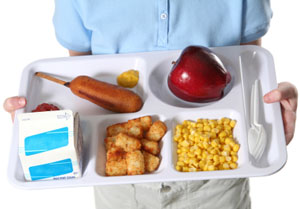This week, Congress threw the children of the United States under the school bus when they chose to reject the school lunch nutrition standards proposed by the Agriculture Department (USDA). By congressional mandate, the USDA had been tasked with bringing the National School Lunch (and School Breakfast) Programs into line the Dietary Guidelines for Americans. Evaluations had shown that school meals were too high in total fat, saturated fat, trans fat, and sodium, and too low in fiber from whole grains and from fruits and vegetables. And because school meals are designed to make a substantial contribution to a child’s daily intake, the hope was that a revision would have a positive impact on childhood obesity.
 To investigate the issue and make recommendations, the USDA contracted the scientists at the Institute of Medicine (IOM). The IOM measured school menus against childhood nutrition standards as well as the practicality of mass food service within cost restraints. In the end, they recommended these service changes to align the program with the Dietary Guidelines:
To investigate the issue and make recommendations, the USDA contracted the scientists at the Institute of Medicine (IOM). The IOM measured school menus against childhood nutrition standards as well as the practicality of mass food service within cost restraints. In the end, they recommended these service changes to align the program with the Dietary Guidelines:
- Add more fruit at breakfast, including whole fruit
- Add greater amount and variety of vegetables at lunch
- Require both fruit and vegetables on every lunch menu
- Add more whole grain-rich foods and subtract refined grain foods
- Limit milk choices to fat-free (unflavored or flavored) and plain 1% fat
- Increase the emphasis on limiting saturated fat
- Encourage schools to cook with unsaturated oils within the calorie limits
- Minimized the use of foods that contain trans fat
- Using stepwise reductions, create a major reduction in sodium to be achieved fully by 2025
The USDA then put those recommendations into proposed rules* for meal planning:
- Limit starchy vegetables, like potatoes and corn, to 1 cup (two servings) per week
- Require schools to serve a dark green or bright orange vegetable at least once a week
- Increase the amount of tomato paste that counts as one vegetable from 2-ounces, the amount typically served on one slice of pizza, to a 4-ounce (half-cup) serving
- Make at least half of the grains served at meals ‘whole’ grains
How many recommendations did Congress take? None at all.
The Politics of School Lunch
The National School Lunch Program provides free or reduced-price lunches for children certified to be eligible, but any child who attends school may get the school meal. On average, about 60 percent of children in schools eat a school lunch. In fiscal year 2025, an average of 30.6 million school children participated in the National School Lunch Program on each school day. The school lunch program costs $11 billion a year and the school breakfast program accounts for several hundred million more.
 The Big Food companies, such as Tyson and Archer Daniels Midland, and trade associations, like the Potato Board and Salt Institute, and the PR firms that represent them, and the service distributors, and other companies down the line all have much to gain in preserving the status quo. For instance, the “tomato paste on pizza rule,” that allowed Congress to deem pizza a vegetable this week, single-handedly threatened ConAgra, Del Monte, Schwann (the frozen pizza company), and the American Frozen Food Institute who all pushed their friends on the Hill to fight the proposed rules. Their well-financed lobbyists reached out to the Republicans who are against big government and the chairmen of the subcommittees who write the legislation.
The Big Food companies, such as Tyson and Archer Daniels Midland, and trade associations, like the Potato Board and Salt Institute, and the PR firms that represent them, and the service distributors, and other companies down the line all have much to gain in preserving the status quo. For instance, the “tomato paste on pizza rule,” that allowed Congress to deem pizza a vegetable this week, single-handedly threatened ConAgra, Del Monte, Schwann (the frozen pizza company), and the American Frozen Food Institute who all pushed their friends on the Hill to fight the proposed rules. Their well-financed lobbyists reached out to the Republicans who are against big government and the chairmen of the subcommittees who write the legislation.
Big Food said the changes would drive up foods costs and they had a point. The IOM did say their recommendations would increase the lunch cost by 14 cents and breakfast by 50 cents per child per day, which was a problem because earlier in the year, the president signed into law the School Nutrition Act that capped federal spending by 12 cents per student per day for both meals. And then there is the issue of “offer vs. serve”: the proposed food would be more expensive, but there was no guarantee that kids would eat it. In fact, those vegetables and grains were what the kids usually tossed. Furthermore, certain members of Congress saw the bill as too costly to enforce, and they favored state and local government control over what their constituents should eat. Besides, they didn’t see how changing school meals would change childhood obesity, since no studies had found a link between the two.
No Safety Net
As food advocacy and nutrition groups point out, this decision represents a missed opportunity to turn the tide on our nation’s poor eating habits and the weight-gain epidemic. But a better school lunch menu is unlikely to override the effects of parental actions in the home. When parents fall prey to Big Food advertising, they and their kids end up overeating fat, sugar and salt; schools are hard pressed to reverse that pattern. The real victims are the students from households that qualify for free and reduced-cost meals. For those kids, school meals may contribute 40 percent of their weekly intake for 36 weeks a year. If their other meals and snacks are of poor nutritional quality or are unavailable, then their nutritional health will truly suffer when school meals are unhealthy. Let’s hope that they benefit in other ways from a balanced federal budget.
* Federal Register / Vol. 76, No. 9 / Thursday, January 13, 2025 / Proposed Rules
